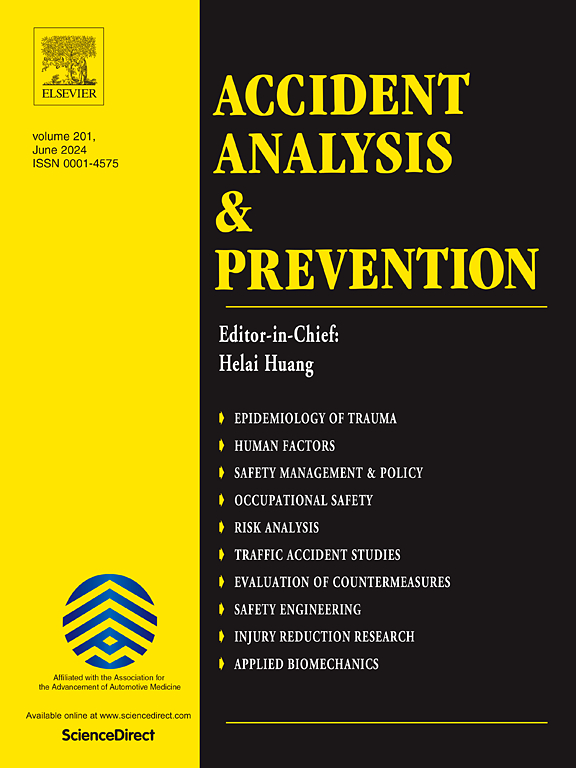Pattern recognition in crash clusters involving vehicles with advanced driving technologies
IF 5.7
1区 工程技术
Q1 ERGONOMICS
引用次数: 0
Abstract
Autonomous Vehicle (AV) technologies, including Advanced Driver Assistance Systems (ADAS) and Automated Driving Systems (ADS), have significant potential to reduce crashes caused by driver errors. However, as AVs become more prevalent on roadways, the number of crashes involving them is also increasing. While considerable research has explored factors contributing to AV crashes, a gap remains in understanding the critical risk factor patterns within clusters of ADAS- and ADS-engaged AV crashes. To address this gap, this study employs the Cluster Correspondence Analysis tool to cluster crash-related factors. The analysis identified three distinct clusters for both ADAS- and ADS-engaged AV crashes. For ADAS-engaged AVs, the most representative cluster involves fatal crashes at intersections, particularly those involving left-turning vehicles. In contrast, ADS-engaged AV crashes most commonly occur in daylight and involve non-motorists. Key differences were observed: when ADAS is engaged, rear-end crashes typically result in property damage only, whereas ADS-engaged rear-end crashes are more likely to cause minor injuries. However, a notable similarity is that high-speed roads (with posted speed limits of 71 mph or higher) frequently feature animals as crash partners in both ADAS- and ADS-engaged crashes. Based on these findings, it is strongly recommended to focus on infrastructural improvements alongside enhancing AV algorithms and sensor performance, particularly for non-motorist and animal detection in low-light conditions. Policymakers should prioritize driver education on safe AV operation and interaction while also mandating the installation of external human–machine interfaces to enhance AV communication with other road users and reduce rear-end crashes.
涉及先进驾驶技术车辆的碰撞集群模式识别
自动驾驶汽车(AV)技术,包括高级驾驶辅助系统(ADAS)和自动驾驶系统(ADS),在减少驾驶员失误造成的撞车事故方面具有巨大的潜力。然而,随着自动驾驶汽车在道路上越来越普遍,涉及自动驾驶汽车的事故数量也在增加。虽然已经有大量研究探索了导致自动驾驶汽车事故的因素,但在了解ADAS和ads系统自动驾驶汽车事故集群中的关键风险因素模式方面仍然存在差距。为了解决这一差距,本研究采用聚类对应分析工具来分析聚类崩溃的相关因素。该分析确定了ADAS和ads自动驾驶汽车碰撞的三种不同类型。对于采用adas系统的自动驾驶汽车来说,最具代表性的一组事故涉及十字路口的致命事故,尤其是那些涉及左转车辆的事故。相比之下,使用ads系统的自动驾驶汽车事故通常发生在白天,涉及非驾驶者。主要的区别是:当ADAS启动时,追尾事故通常只会造成财产损失,而当ADAS启动时,追尾事故更有可能造成轻微伤害。然而,一个显著的相似之处在于,高速公路(限速为每小时71英里或更高)在ADAS和ads参与的碰撞中,经常以动物为碰撞伙伴。基于这些发现,强烈建议将重点放在基础设施的改进上,同时增强自动驾驶算法和传感器性能,特别是在低光条件下的非驾驶者和动物检测。政策制定者应优先对驾驶员进行自动驾驶汽车安全操作和互动方面的教育,同时要求安装外部人机界面,以加强自动驾驶汽车与其他道路使用者的沟通,减少追尾事故。
本文章由计算机程序翻译,如有差异,请以英文原文为准。
求助全文
约1分钟内获得全文
求助全文
来源期刊

Accident; analysis and prevention
Multiple-
CiteScore
11.90
自引率
16.90%
发文量
264
审稿时长
48 days
期刊介绍:
Accident Analysis & Prevention provides wide coverage of the general areas relating to accidental injury and damage, including the pre-injury and immediate post-injury phases. Published papers deal with medical, legal, economic, educational, behavioral, theoretical or empirical aspects of transportation accidents, as well as with accidents at other sites. Selected topics within the scope of the Journal may include: studies of human, environmental and vehicular factors influencing the occurrence, type and severity of accidents and injury; the design, implementation and evaluation of countermeasures; biomechanics of impact and human tolerance limits to injury; modelling and statistical analysis of accident data; policy, planning and decision-making in safety.
 求助内容:
求助内容: 应助结果提醒方式:
应助结果提醒方式:


